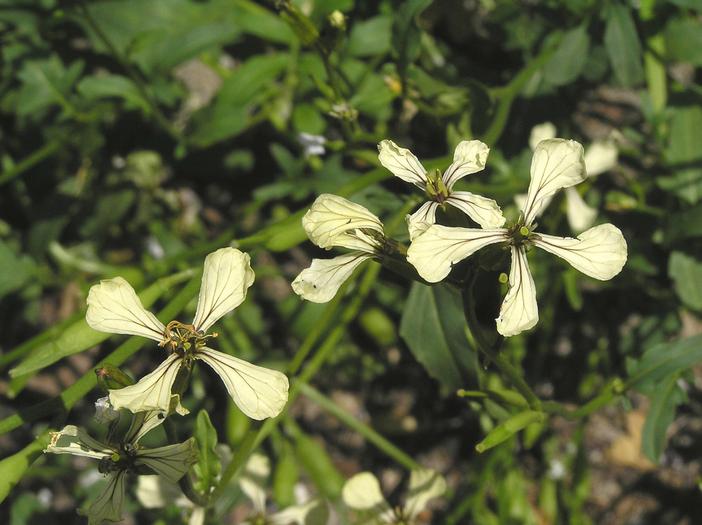Arugula
(Eruca sativa)
Arugula (Eruca sativa)
/
/

阿橋花譜 HQ Flower Guide
CC BY-SA 2.0
Image By:
阿橋花譜 HQ Flower Guide
Recorded By:
Copyright:
CC BY-SA 2.0
Copyright Notice:
Photo by: 阿橋花譜 HQ Flower Guide | License Type: CC BY-SA 2.0 | License URL: https://creativecommons.org/licenses/by-sa/2.0/ | Uploader: 阿橋 KHQ | Publisher: Flickr













Estimated Native Range
Summary
Eruca sativa, commonly known as arugula or rocket, is an annual herb native to the Mediterranean region, including parts of Europe, North Africa, and Western Asia. It thrives in disturbed habitats, such as roadsides and fields, as well as in the traditional kitchen gardens of the region. Arugula grows to a height of 8 to 39 inches with a spread of about 12 to 18 inches. Its leaves are deeply lobed and pinnate, forming a rosette at the base. The plant produces creamy white flowers marked with distinctive purple veins during the flowering season, which typically occurs in the late spring to early summer. The flowers are moderately showy and are followed by siliquae (seed pods) that are noteworthy in their own right.
Arugula is valued for its leaves, which add a fresh, tart, bitter, and peppery flavor to salads and other dishes. It is rich in folate, vitamin K, vitamin C, and potassium, making it a nutritious addition to the diet. In cultivation, arugula is often grown for its edible leaves in vegetable gardens, as a border plant, or in containers. It prefers full sun to part shade and grows best in fertile, well-drained soils. Arugula is relatively easy to maintain, requiring regular watering and the removal of spent flowers to encourage continued leaf production. It can be direct-seeded or transplanted and is known for its fast growth rate. However, it can become invasive outside its native range, so gardeners should check local regulations before planting.CC BY-SA 4.0
Arugula is valued for its leaves, which add a fresh, tart, bitter, and peppery flavor to salads and other dishes. It is rich in folate, vitamin K, vitamin C, and potassium, making it a nutritious addition to the diet. In cultivation, arugula is often grown for its edible leaves in vegetable gardens, as a border plant, or in containers. It prefers full sun to part shade and grows best in fertile, well-drained soils. Arugula is relatively easy to maintain, requiring regular watering and the removal of spent flowers to encourage continued leaf production. It can be direct-seeded or transplanted and is known for its fast growth rate. However, it can become invasive outside its native range, so gardeners should check local regulations before planting.CC BY-SA 4.0
Plant Description
- Plant Type: Herb
- Height: 0.6-3 feet
- Width: 0.6-1.5 feet
- Growth Rate: Rapid
- Flower Color: White, Yellow
- Flowering Season: Spring, Summer
- Leaf Retention:
Growth Requirements
- Sun: Full Sun
- Water: Low, Medium
- Drainage: Medium
Common Uses
Bee Garden, Border Plant, Edible*Disclaimer: Easyscape's listed plant edibility is for informational use. Always verify the safety and proper identification of any plant before consumption., Low Maintenance, Potted Plant, Street Planting
Natural Habitat
Mediterranean region, including disturbed habitats and traditional kitchen gardens
Other Names
Common Names: Rucola, Rocket, Roquette
Scientific Names: , Eruca sativa,
GBIF Accepted Name: